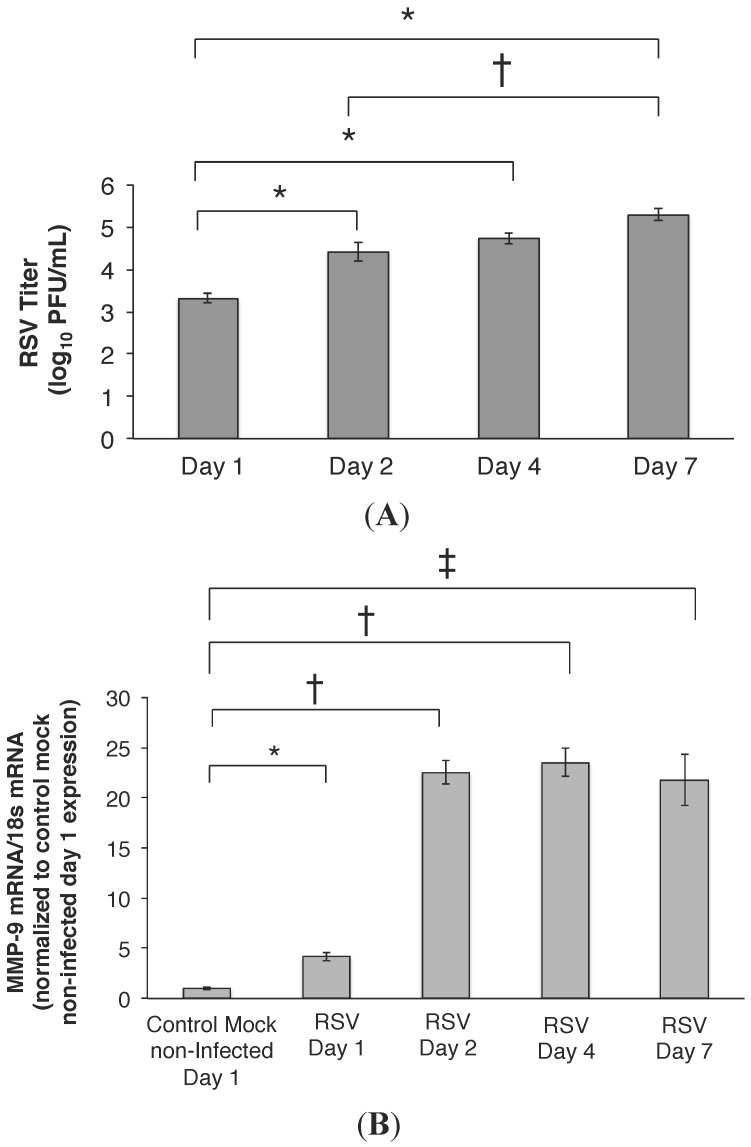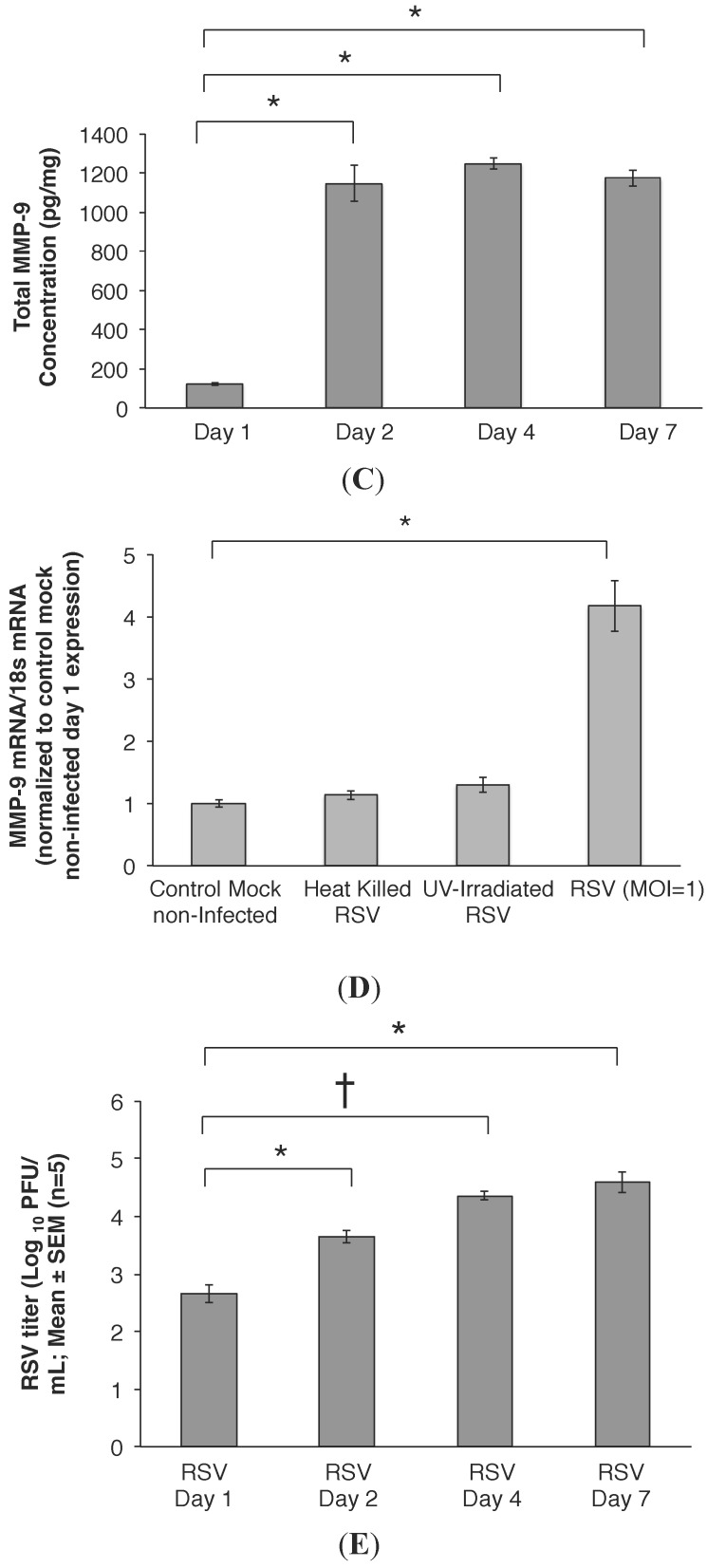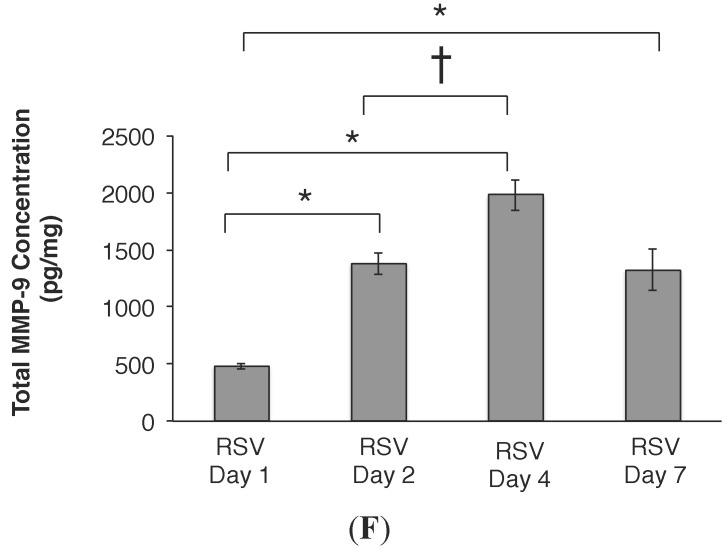Figure 1.
(A) RSV titer is increased in infected HBE cells over time. 16HBE cells were permissive to RSV infection, with increasing viral titer detected over time. At 24 h PI, the RSV titer was 3.2 ± 0.1 log10 PFU/mL, which increased to 4.4 ± 0.2 and 4.7 ± 0.1 log10 PFU/mL, respectively, on days 2 and 4 PI. By day 7 PI, the RSV titer was approximately 1–2 logs higher compared to the 24 h and 48 h time point. Data represent mean ± SEM. * p < 0.001 and † p = 0.003 as indicated, by ANOVA followed by Tukey-Kramer multiple comparisons test; (B) RSV infection is a potent stimulus of MMP-9 mRNA expression. MMP-9 mRNA was four-fold higher in the RSV infected HBE cells (MOI = 1) compared to control (mock non-infected) cells on day 1 (* p < 0.03). MMP-9 mRNA levels remained increased on days 2 to 7 post RSV infection, and were approximately 21–23-fold higher compared to control non-infected cells. Data represent mean ± SEM. † p < 0.01 and ‡ p < 0.002 as indicated, by ANOVA followed by Tukey-Kramer multiple comparisons test; (C) Total MMP-9 concentration is increased in RSV infected cell media. Total MMP-9 concentration in the media of RSV infected 16HBE cells first peaked on day 2 PI compared to day 1, correlating with the increased in MMP-9 mRNA measured (Figure 1B). MMP-9 concentration remained increased on day 4 and 7 PI, relative to levels measured on day 1. Data represent mean ± SEM. * p < 0.001 as indicated, by ANOVA followed by Tukey-Kramer multiple comparisons test; (D) Viral infectivity is necessary for induction of MMP-9 expression in human airway epithelial cells. Exposure of 16HBE cells to heat killed and UV light treated RSV (MOI = 1) failed to stimulate increases in MMP-9 mRNA, suggesting that MMP-9 gene expression and protein release was specific to RSV infection (and not just to viral structural protein exposure). MMP-9 mRNA was approximately four-fold higher in the RSV infected cells (MOI = 1) compared to control mock non-infected, heat killed and UV-irradiated RSV exposed cells. Data represent mean ± SEM. * p < 0.03; (E) Primary human lower airway cells are permissive to RSV infection. Primary human airway cells were obtained from lung transplant recipients, and grown at an air–liquid interface. Cells were infected with RSV at MOI of 1, and viral titers were determined over time. On day 1 PI, RSV titer was 2.7 ± 0.1 log10 PFU/mL, which increased to approximately 4–5 log10 PFU/mL by days 2 to 7 PI. Data represent mean ± SEM. * p < 0.01 and † p < 0.002 as indicated, by ANOVA followed by Tukey-Kramer multiple comparisons test; (F) RSV infection induces MMP-9 release from primary human airway epithelial cells. MMP-9 levels were detected consistently in the apical media of RSV infected primary airway cells. Levels on days 2 to 7 PI were higher than MMP-9 concentration measured on day 1, with peak concentration found on day 4 PI. Data represent mean ± SEM. * p < 0.0001 and † p < 0.001 as indicated, by ANOVA followed by Tukey-Kramer multiple comparisons test.



